Explore the captivating world of Lovebirds with our comprehensive guide. Unveil their unique traits, behavior, care, and more. Your journey to joyful companionship starts here!
Introduction to Lovebirds
A lovebird is a small breed of parrots that belongs to the genus Agapornis. These birds are affectionate in behavior towards their mates, often forming strong bonds with each other. Lovebirds are native to Africa and are named for their monogamous and loving relationships. Lovebirds are social creatures and thrive on interaction, both with their human caregivers and their avian companions. These birds are popular pets due to their playful nature and the strong connections they form with their owners. They require proper care, including a balanced diet, a spacious cage, and mental stimulation to keep them happy and healthy. Don’t worry we will going to discuss each and every aspects about Lovebirds. Lovebirds are also known for their chirping and vocalizations, which add to their charm as pets. Lovebirds are cute and small sized parrots, which are mostly known for their strong pair bonds. They’re known for their vibrant personalities, playful antics, and, of course, their adorable displays of affection.
Lovebirds Characteristics: Behavior and Socialization
Lovebirds, true to their name, are renowned for their strong pair bonds and captivating displays of affection. But these vibrant little parrots also pack a punch of personality, showcasing curiosity, playfulness, and even a bit of feistiness. Let’s delve into their captivating behavior and explore how to socialize them for a happy and fulfilling life. Here are some key characteristics that make lovebirds so special:
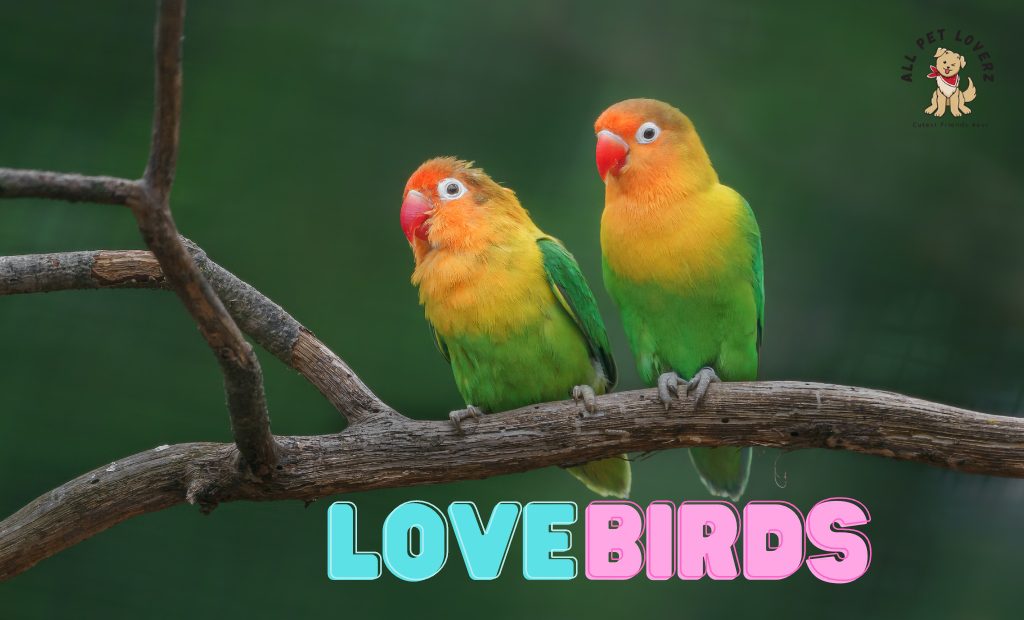
1. Lovebirds are a Devoted Pairs:
- Strong Pair Bonds: Lovebirds form incredibly close bonds with their chosen partners, preening, feeding, and cuddling constantly. They’re practically inseparable, earning the nickname “pocket parrots” for their fondness for snuggling.
- Chirpy Chatters: Communication is key in their love life! They express affection through soft chirps, whistles, and playful nibbles. Witnessing their adorable interactions is a constant source of joy for their human companions.
2. Lovebirds are Active and Energetic:
These little birds are bursting with energy! They love to climb, swing, and explore their surroundings. They’re constantly chirping and chattering, communicating with their mate and expressing their curiosity about the world. Keeping them entertained with toys and opportunities for exercise is essential. Their inquisitive nature keeps them engaged with their environment. They investigate new objects, forage for hidden treats, and delight in discovering something new each day.
3. Lovebirds are Intelligent and Playful:
Lovebirds are quick learners and enjoy being challenged mentally. They can learn tricks, mimic sounds including words, and even solve simple puzzles. This makes training and playtime fun and rewarding for both bird and owner. Their playful nature makes them a joy to watch as they engage in acrobatic feats and silly antics.
4. Lovebirds are Feisty and Territorial:
While lovebirds can be incredibly sweet and affectionate with their chosen partner, they can also be feisty and territorial, especially towards other birds. They may become jealous if they feel their mate is paying attention to someone else, and they can be quite vocal and assertive in defending their territory. They may puff up their feathers or give warnings through loud chirps if they feel threatened. Understanding their territorial instincts is crucial for peaceful cohabitation.
5. Lovebirds Comes in Vibrant Colors:
Lovebirds come in a variety of beautiful colors, from the classic peach-faced with its rosy cheeks to the striking Fischer’s lovebird with its emerald green plumage. Each species has its own unique markings and patterns, making them a feast for the eyes.
6. Lovebirds can Good Mimics:
Many lovebirds are talented mimics and can learn to imitate sounds and even human speech. Their charming personalities shine through in their playful mimicry, adding another layer of entertainment to their companionship.
7. Lovebirds are Social:
They crave interaction and can get lonely if neglected. They thrive on attention and playtime with their humans.
8. Lovebirds are Loyal:
Once bonded, they can be devoted companions for many years, showering their chosen humans with affection.
Types Of Lovebirds
The world of lovebirds is surprisingly diverse! There are nine species in the Agapornis genus, each with its own unique charm and characteristics. Here’s a quick overview of the main types:
The 3 Most Popular Lovebirds Species
- Peach-faced Lovebird: These are the most common lovebirds kept as pets, known for their playful personalities, vibrant pink cheeks, and green bodies. They’re intelligent, energetic, and relatively easy to care for.
- Masked Lovebird (Yellow-collared Lovebird): Slightly calmer than peach-faced birds, these beauties have stunning black masks, yellow collars, and green plumage. They’re intelligent and playful, but less vocal than their cousins.
- Fischer’s Lovebird: These stunning emerald green birds with contrasting red beaks are lively and playful, but can be more nippy and territorial than the other two. They require experienced owners.
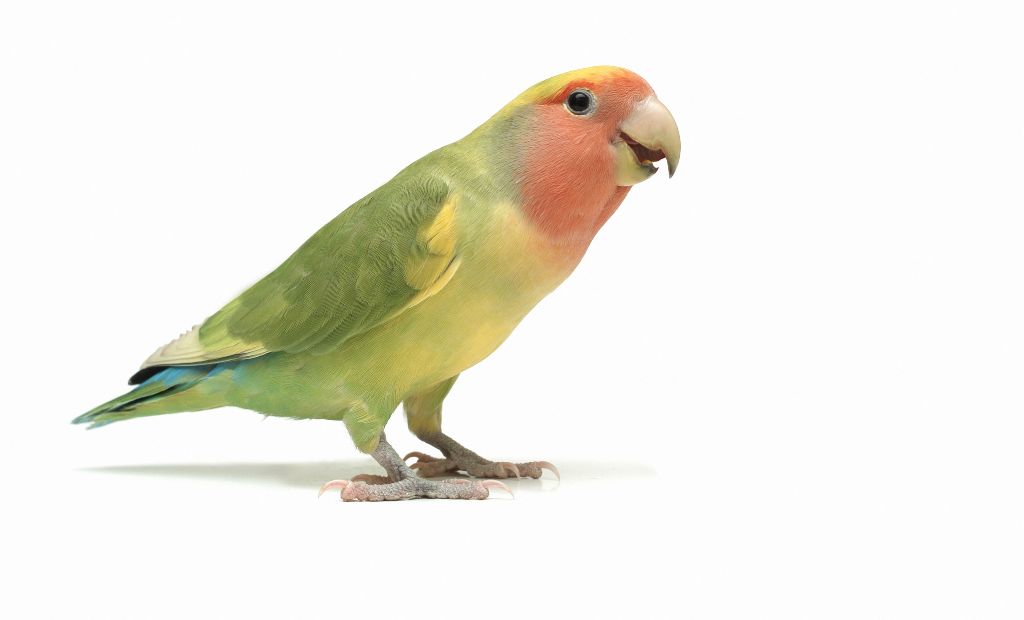
The Other Six: Less Common, But Captivating Lovebirds breeds
- Grey-headed Lovebird: The only Madagascan species, these gentle birds have gray heads and green bodies. They’re quieter and less playful than the “Big Three”, but make affectionate companions.
- Black-cheeked Lovebird: These enigmatic beauties have striking black faces, yellow chests, and green bodies. They’re social and playful, but rarer and more challenging to breed in captivity.
- Lilian’s Lovebird (Nyasa Lovebird): These petite birds with turquoise faces and green bodies are playful and affectionate, but less common in aviculture due to breeding difficulties.
- Black-winged Lovebird (Abyssinian Lovebird): These striking lovebirds have black wings, contrasting with their green bodies and red beaks. They’re lively and playful, but can be loud and aggressive.
- Black-collared Lovebird (Swindern’s Lovebird): These rare beauties have black collars, green bodies, and red beaks. They’re shy and not commonly kept as pets due to their sensitivity to stress.
- Red-faced Lovebird: These brightly colored birds have red faces, black beaks, and green bodies. They’re active and playful, but require experienced owners as they can be challenging to tame.
Beyond Species: Color Mutations Each species also has numerous color mutations, adding further variety to the lovebird world. From lutino (completely yellow) to cinnamon (brown) and pieds (multicolored), the possibilities are endless!
Cost Of Lovebirds
Let’s come and take a look on the pricing factors of a Lovebird. The price of a lovebird can vary depending on several factors, including:
- Species: Different species have different levels of popularity and availability, which can affect their price.
- Color Mutation: Rare or unusual color mutations can be significantly more expensive than birds with common plumage.
- Age: Hand-fed babies typically cost more than older birds, but they are also usually tamer and easier to bond with.
- Breeder Reputation: Reputable breeders who prioritize the health and well-being of their birds may charge more than pet stores or private sellers.
- Location: Prices can vary slightly depending on your location also.
Here’s a general overview of the price range for each lovebird species:

Peach-faced Lovebird: $50-$150 (Most common and affordable)

Masked Lovebird (Yellow-collard Lovebird): $75-$200
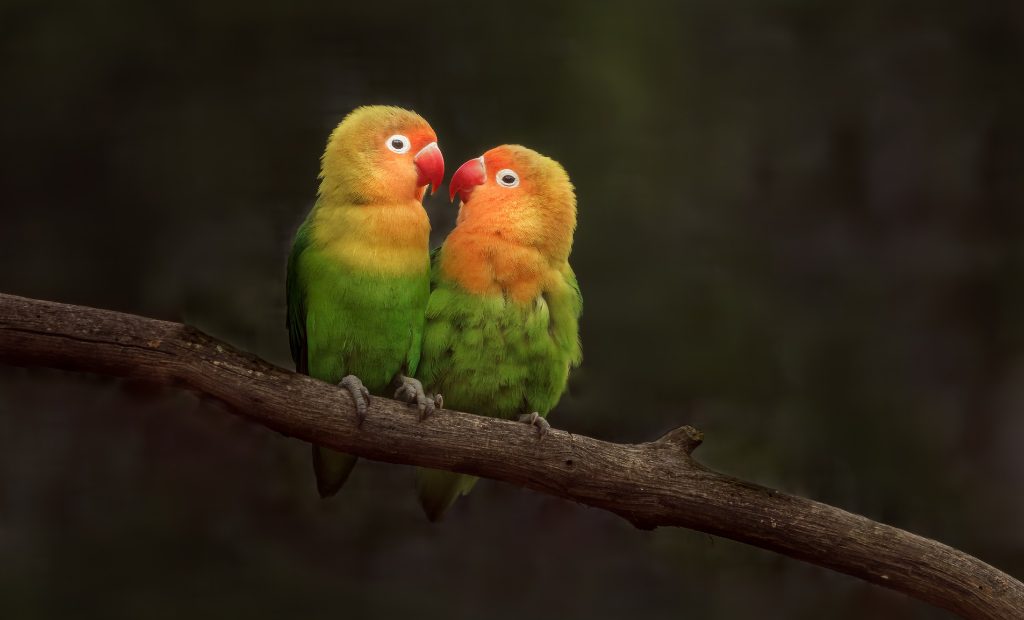
Fischer’s Lovebird: $100-$300
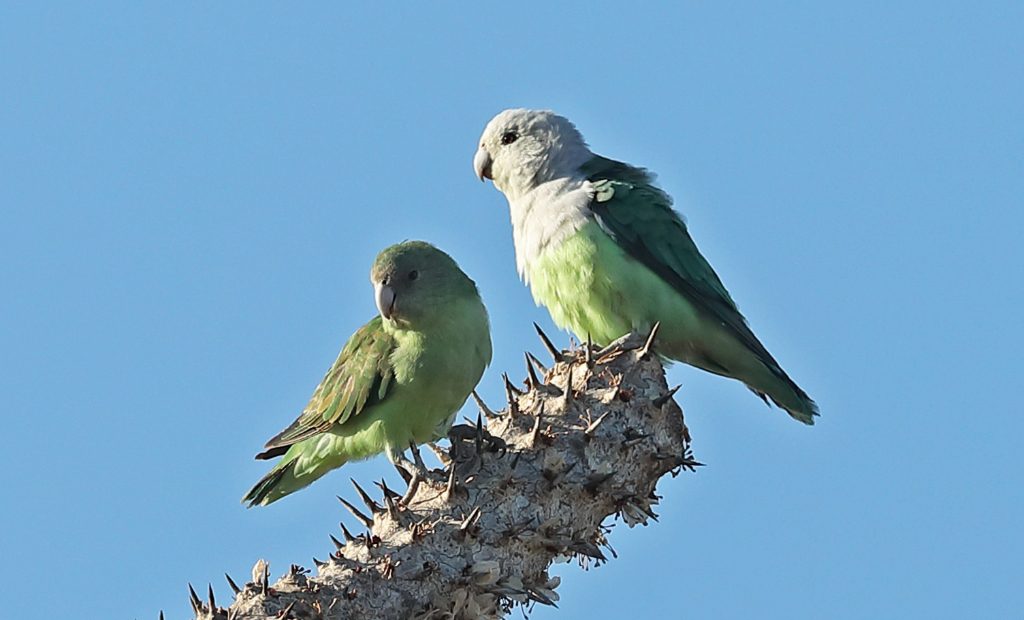
Grey-headed Lovebird: $200-$500 (Less common and more expensive)
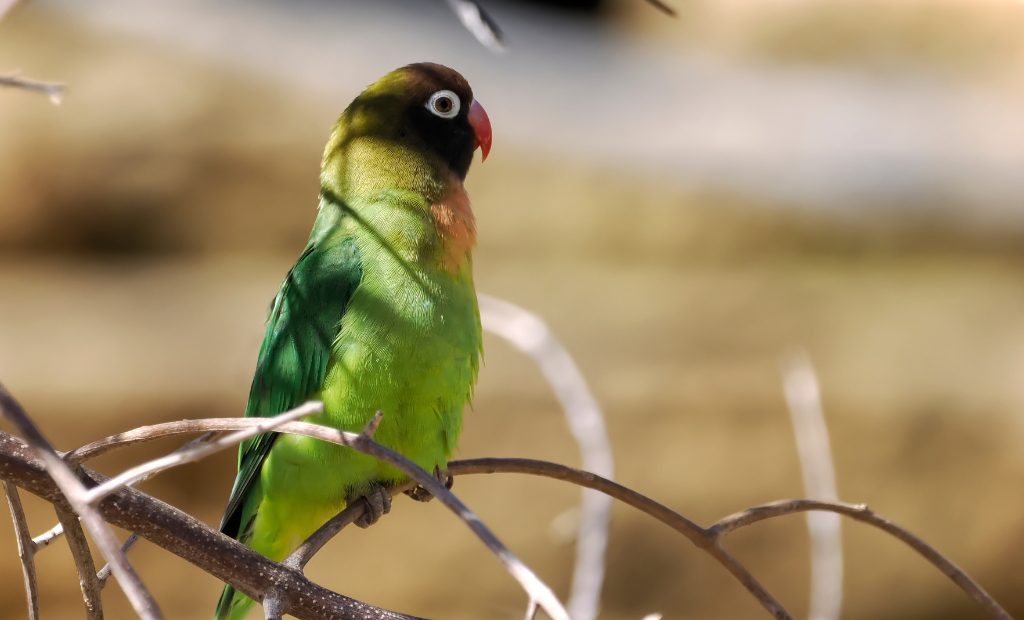
Black-cheeked Lovebird: $300-$1000 (Rare and very expensive)

Lilian’s Lovebird (Nyasa Lovebird): $500-$1500 (Rare and challenging to breed)

Black-winged Lovebird (Abyssinian Lovebird): $200-$500
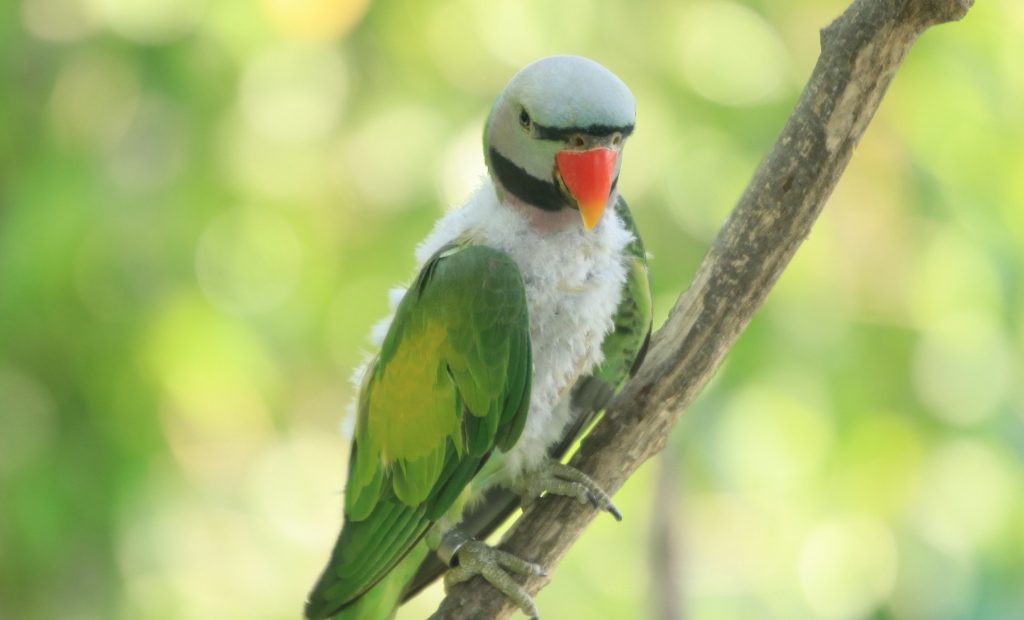
Black-collared Lovebird (Swindern’s Lovebird): $1000-$3000 (Extremely rare and delicate)

Red-faced Lovebird: $300-$800 (Active and playful, but can be challenging)
"Please keep in mind that these are just estimates, and the actual price of a lovebird can vary considerably. It's always best to contact a reputable breeder or avian rescue organization for the most accurate pricing information."
Housing and Habitat of lovebirds
Lovebirds are social creatures who thrive on interaction and exploration. Providing them with the right housing and habitat is crucial for their physical and mental well-being. Here’s a guide to creating a space your feathered friends will adore:
Cage Basics for Lovebirds:
- Size Matters: A spacious cage is essential for lovebirds’ active lifestyle. Aim for a minimum size of 32 inches long, 20 inches wide, and 20 inches high (81 x 50 x 50 cm) for a pair. Remember, bigger is always better!
- Multiple Levels: Provide vertical space with shelves, branches, and ladders for climbing and exploring. This keeps them active and prevents boredom.
- Strong and Secure: Choose a sturdy cage made of durable materials like steel or wrought iron. Wire mesh should be close enough to prevent escapes but not constrict their movement.
Habitat Essentials For Lovebirds:
- Perches: Offer a variety of perches in different shapes, sizes, and textures to keep their feet stimulated and prevent pressure sores. Natural wood perches are ideal, but be sure they’re safe and free from harmful chemicals.
- Food and Water Dishes: Use stainless steel or ceramic bowls for easy cleaning and hygiene. Place them strategically to prevent spillage and contamination.
- Toys and Activities: Lovebirds are intelligent and playful, so keep them entertained with a variety of toys like bells, swings, foraging boxes, and chewable items. Rotate the toys regularly to prevent boredom.
- Safe and Secure: Place the cage in a quiet, draft-free location away from direct sunlight and noise. Avoid placing it near doors, windows, or vents.
- Social Interaction: Lovebirds crave interaction with their humans. Place the cage in a room where you spend a lot of time so they can feel part of the family.
- Natural Light: Ensure they get enough natural light, but avoid direct sunlight which can overheat the cage.
Bonus Tips For Take Care of Your Lovebirds As Pets:
- Cleanliness is Key: Regularly clean the cage and replace food and water daily. Maintain good hygiene to prevent the spread of bacteria and parasites.
- Varied Diet: Provide a healthy diet of pellets, fresh fruits and vegetables, and occasional seeds and treats. Consult an avian veterinarian for a proper feeding plan.
- Socialization: Spend time interacting with your lovebirds daily. Talk to them, play with them, and handle them gently to build trust and strengthen your bond.
“By following these tips and providing a stimulating and loving environment, you can create a happy and healthy habitat for your feathered companions. Remember, lovebirds are social creatures, so giving them the attention and care they deserve will reward you with years of chirpy companionship and delightful antics.“

Feeding and Nutrition of Lovebirds
Keeping your lovebirds healthy and chirpy requires providing them with a nutritious and varied diet. Here’s a guide to feeding your feathered friends:
The Essentials Foods For Lovebirds
Lets Know about “What are the essential foods that we can give to our Lovebirds as a Pets”.
- Pellets: High-quality pelleted food formulated for lovebirds should be the foundation of their diet. Pellets offer a balanced mix of nutrients, vitamins, and minerals essential for their well-being. Aim for around 75% of their daily intake to come from pellets.
- Fresh Fruits and Vegetables: Provide a daily serving of fresh, chopped fruits and vegetables like apples, berries, pears, carrots, broccoli, leafy greens, and sweet potatoes. Introduce new options gradually to avoid digestive upset.
- Seeds and Treats: Seeds like millet and sunflower seeds can be offered as occasional treats in moderation. Avoid fatty nuts and greasy food items that can be harmful to their health.
Variety is Key:
- While pellets offer a balanced diet, don’t rely solely on them. Introduce a variety of fresh fruits and vegetables daily to keep things interesting for your birds and ensure they get a wider range of nutrients.
- Rotate and mix different types of seeds and treats to prevent boredom and encourage foraging behavior.
Portion Control:
- Overfeeding can lead to obesity and other health problems. Follow the recommended feeding guidelines on the pellet packaging and adjust based on your lovebird’s activity level and individual needs.
- Monitor their food intake and adjust portions as needed. Leftover food shouldn’t be offered the next day, as it can become stale or spoiled.
Fresh Water:
- Always provide clean, fresh water in a suitable drinking bowl. Replace the water daily and clean the bowl regularly to prevent bacterial growth.
Additional Tips:
- Avoid processed foods, sugary treats, and fatty foods.
- Place food and water dishes at different heights within the cage to encourage exercise and exploration.
- Offer foraging toys and puzzles to keep them mentally stimulated and entertained while searching for their food.
- Consult your avian veterinarian for a personalized diet plan based on your lovebird’s age, health, and activity level.
“By following these guidelines and providing a balanced and varied diet, you can ensure your lovebirds remain healthy, happy, and full of life for years to come! Remember, a proper diet is crucial for their physical and mental well-being, so prioritize good nutrition and watch your feathered friends thrive.“

Socialization Tips For Making Your Pet Lovebird Socialized
- Early Start: Hand-raising chicks from a young age helps them become tame and comfortable with human interaction. However, even adult birds can be socialized with patience and gentle handling.
- Gradual Approach: Start with offering treats from your hand, graduating to gentle strokes on their head or beak once they feel comfortable. Avoid forcing interaction and let them approach you at their own pace.
- Playtime is Bonding Time: Regular playtime filled with toys, cuddles, and gentle conversations strengthens your bond and fosters trust. Let their playful nature guide your interactions.
- Patience and Consistency: Remember, socialization takes time and patience. Be consistent with your approach, offer positive reinforcement, and celebrate their progress, no matter how small.
“By understanding their vibrant personalities and providing opportunities for socialization, you can create a fulfilling life for your feathered companions. Embrace their quirky behaviors, cherish their displays of affection, and prepare to be captivated by the delightful world of lovebirds!“
Health and Veterinary Care of Lovebirds
Like any precious pet, your lovebirds require routine veterinary care to maintain their health and well-being. Here’s a comprehensive guide to ensuring your feathered friends get the best possible care:
Preventative Care:
- Annual Checkups: Schedule regular checkups with an avian veterinarian familiar with lovebirds. They’ll perform a physical examination, assess their overall health, and discuss any potential issues.
- Feather & Beak Trims: Overgrown feathers and beaks can hinder their movement and eating. Consult your vet for proper trimming every 6-12 months.
- Nutritional Guidance: A balanced diet is crucial for their health. Discuss their current diet with your vet and receive personalized recommendations based on their age, activity level, and individual needs.
- Parasite Control: Regular parasite screenings and preventive medication are essential to keep them free from internal and external parasites.

Common Health Concerns:
- Beak and Feather Disease: This contagious viral disease can cause feather loss, abnormal beak growth, and immunosuppression. Consult your vet immediately if you notice any suspicious symptoms.
- Proventricular Dilatation Disease (PDD): This digestive condition affects the crop and can lead to regurgitation, weight loss, and lethargy. Early diagnosis and treatment are crucial.
- Bacterial and Fungal Infections: Lovebirds are susceptible to various bacterial and fungal infections. Watch for signs like respiratory problems, diarrhea, or skin abnormalities and seek veterinary attention promptly.
- Nutritional Deficiencies: An unbalanced diet can lead to deficiencies in vitamins, minerals, and calcium. Ensure they receive a proper diet and consult your vet if you suspect any deficiencies.
Emergency Situations:
- Accidents and Injuries: Be prepared for accidents like wing or leg fractures, cuts, or burns. Have contact information for an emergency avian vet readily available and seek immediate professional help if needed.
- Sudden Changes in Behavior: Lethargy, loss of appetite, difficulty breathing, or abnormal movements can indicate serious health problems. Don’t hesitate to consult your vet for a diagnosis and treatment plan.
Additional Tips:
- Maintain a Clean and Safe Environment: Regularly clean their cage and accessories to prevent the spread of bacteria and parasites. Provide safe toys and ensure their surroundings are free from hazards like electrical cords or toxic plants.
- Observe Your Birds: Pay close attention to their daily behavior, appetite, and activity levels. Early detection of any changes can make a significant difference in their treatment and recovery.
- Build Trust with Your Pet: Regular visits and positive interactions with your avian pet will help your lovebirds feel more comfortable during exams and procedures.
“By prioritizing preventative care, recognizing common health concerns, and responding promptly to emergencies, you can ensure your lovebirds receive the best possible veterinary care and live long, healthy lives filled with chirps and playful antics. Remember, they depend on you to advocate for their well-being, so make their health a top priority.“

Lovebird Training and Enrichment
Lovebirds, with their intelligence and playful personalities, are surprisingly adept at training and thrive on stimulating activities. Here’s a guide to engaging your feathered friends and developing a strong bond through enriching interactions:
Training Tips For Lovebirds:
- Positive Reinforcement: Reward desired behaviors with treats, praise, or gentle scratches. This positive approach builds trust and encourages them to learn new tricks.
- Short & Consistent Sessions: Keep training sessions short, around 5-10 minutes at a time, and conduct them daily for better retention. Consistency is key!
- Start Simple: Begin with basic commands like “step up” or “target” using a designated target stick. Once they master these, gradually introduce more complex tricks like waving, turning around, or fetching.
- Tailor to their interests: Observe their natural behaviors and tailor your training to their strengths. If they love climbing, teach them to navigate an obstacle course made of perches and ropes. If they’re vocal, encourage them to mimic sounds or words.
- Patience and Fun: Remember, training should be enjoyable for both you and your lovebird. Be patient, celebrate their progress, and most importantly, have fun together!
Enrichment Ideas:
- Foraging Fun: Hide their food or treats in various places within the cage or room, encouraging them to use their natural foraging instincts. You can use foraging toys, paper bags, or even cardboard boxes to create a fun treasure hunt.
- Toys and Puzzles: Provide a variety of engaging toys, from swings and bells to foraging boxes and chewable items. Rotate the toys regularly to keep things fresh and prevent boredom. You can even create DIY puzzles using cardboard boxes and treats.
- Obstacle Courses: Create a mini obstacle course inside or outside the cage using branches, ladders, and cardboard boxes. This encourages climbing, exploration, and problem-solving skills.
- Socialization and Interaction: Spend time interacting with your lovebirds daily. Talk to them, sing songs, and play with them gently. Encourage them to climb onto your finger or shoulder and offer head scratches and cuddles.
- Outdoor Adventures: When weather permits, allow your lovebirds supervised outdoor time in a secure aviary or harness. Exploring new sights and sounds will stimulate their senses and provide enrichment.

Additional Tips:
- Consider Clicker Training: This positive reinforcement technique uses a clicker to mark desired behaviors and can be highly effective with lovebirds.
- Be Mindful of Stress: Avoid loud noises, sudden movements, or unfamiliar visitors around your lovebirds during training or enrichment activities. Create a calm and predictable environment for them to thrive.
- Respect their Individuality: Some lovebirds may be more receptive to training and enrichment than others. Adjust your approach based on their personalities and comfort level.
- Make it a Bonding Experience: Training and enrichment activities are not just about teaching tricks; they’re a wonderful way to build trust, strengthen your bond, and create lasting memories with your feathered companions.
“By incorporating training and enrichment into your lovebird’s daily routine, you’ll keep their minds and bodies active, strengthen your relationship, and ensure they live a happy and fulfilling life. Remember, a little creativity and a lot of love go a long way in enriching the lives of these charming and intelligent little birds.“
Breeding of Lovebirds
While breeding lovebirds can be a rewarding experience, it’s a big responsibility that requires careful planning and consideration. Here’s an overview of the essential steps involved, along with some important factors to remember before embarking on this journey:
Before You Begin for Breeding Procedure of Lovebirds As Pets:
1. Research and Preparation:
- Species Specifics: Different lovebird species have varying breeding requirements and temperaments. Choose a species you’re familiar with and understand their specific needs.
- Legality and Ethics: Be aware of any local regulations regarding avian breeding. Ensure you’re prepared to provide long-term care for any offspring and avoid overbreeding.
- Aviary and Equipment: Provide a spacious and well-equipped aviary for breeding pairs. This includes nesting boxes, perches, food and water stations, and proper ventilation.
- Veterinary Consultation: Schedule a check-up with your avian veterinarian for both potential breeding parents. This ensures they’re healthy and disease-free before breeding.

2. Selecting the Pair:
- Age and Maturity: Opt for birds at least one year old, ensuring physical and mental maturity for successful breeding.
- Compatibility: Observe their interactions. Choose a pair that shows mutual affection, preening each other, and sharing food. Avoid aggressive or incompatible pairs.
- Health and Genetics: Prioritize healthy birds with no genetic defects. Research any potential genetic issues within the chosen species.
Breeding Process of Lovebirds:
- Introduce the Pair: Initially, keep them in separate cages within sight of each other. Allow gradual interaction to build trust and comfort.
- Nesting Box Provision: Once they show breeding interest, introduce a suitable nesting box in the aviary. Provide nesting materials like shredded paper or wood shavings.
- Egg Laying and Incubation: The female typically lays 4-6 eggs. Both parents may participate in incubation, but the female takes on the majority of the responsibility.
- Hatching and Chick Rearing: After 18-21 days, the chicks will hatch. Both parents feed and care for the chicks until they fledge around 5-6 weeks.
Important Points to Remember For Lovebirds Breeding:
- Stress and Disruptions: Minimize stress during the breeding process. Avoid loud noises, sudden movements, and frequent cage cleaning.
- Hygiene and Health: Maintain a clean and hygienic aviary to prevent disease outbreaks. Monitor chick development and consult your vet if you notice any abnormalities.
- Commitment and Responsibility: Be prepared for the long-term commitment of caring for the chicks. Hand-feeding and socialization may be necessary until they’re ready for adoption or independent living.
- Finding Homes: Ensure you have a responsible plan for rehoming any offspring before breeding. Overpopulation can be a serious issue and requires responsible ownership.
Alternatives to Breeding of Lovebirds:
- Adopting Lovebirds: Consider adopting already rescued lovebirds instead of breeding. Many shelters and rescue organizations care for abandoned or surrendered birds in need of loving homes.
- Focus on Bonding: Enjoy the companionship and unique personalities of your lovebirds without focusing on breeding. Providing them with a loving and fulfilling environment can be its own reward.
“Breeding lovebirds requires careful planning, knowledge, and resources. Be sure to weigh the responsibility thoroughly before starting the process. Alternatively, adopting rescued lovebirds or focusing on building a strong bond with your existing feathered companions can be equally rewarding experiences.“
Breeding season of Lovebirds
The breeding season for lovebirds can vary depending on the species and their location. Here’s a breakdown for some common lovebird species:

Peach-faced Lovebird
February – August (with possible peaks in April and June)

Masked Lovebird (Yellow-collared Lovebird)
January – July (with possible peaks in March and May)

Fischer’s Lovebird
January – April (with a possible second season in June-July)

Grey-headed Lovebird
Year-round in mild climates (with peak breeding in spring and summer)

Black-cheeked Lovebird
May – October

Lilian’s Lovebird (Nyasa Lovebird)
June – November

Black-winged Lovebird (Abyssinian Lovebird)
January – April (with possible second season in July-August)

Black-collared Lovebird (Swindern’s Lovebird)
May – August

Red-faced Lovebird
January – June
Factors Influencing Breeding Season of Lovebirds:
- Temperature: Warmer temperatures and longer daylight hours generally trigger breeding behavior.
- Availability of Food and Water: Abundant food and water resources encourage breeding due to increased nesting success potential.
- Photoperiod: Changes in daylight hours can signal the start and end of the breeding season.
- Age and Maturity: Younger birds may not begin breeding until they reach full maturity.
- Health and Nutrition: Healthy and well-nourished birds are more likely to breed successfully.
Additional Points Regarding Breeding Season for Lovebirds:
- Some lovebird species, like the Grey-headed, can breed year-round in warm climates without significant seasonal variations.
- Breeding seasons can be extended or shortened based on specific bird collections and captive environments.
- Breeders generally advise allowing lovebirds to initiate breeding naturally instead of forcing them during specific times.
“Remember, breeding lovebirds is a serious responsibility. If you’re considering it, conduct thorough research, ensure proper preparation, and prioritize the birds’ well-being throughout the process.“
Analytical Reports About Lovebird Populations: Navigating Uncertainty with Insights
According to IUCN Red List of Threatened Species here is some analytical data for each types of love bird species:
1. Nyasa Lovebird: As per the IUCN, the population of the Nyasa Lovebird is declining. This decrease is primarily due to habitat degradation and capture for the pet trade, presenting significant challenges to its ongoing existence in its natural habitat.
2. Fischer’s Lovebird: As indicated by the IUCN, the population of Fischer’s Lovebird is dwindling. This decline is largely attributed to habitat loss and capture for trade, posing considerable threats to its survival in the wild.
3. Black-cheeked Lovebird: As noted by the IUCN, the population of the Black-cheeked Lovebird is in decline. This decrease is primarily due to habitat destruction and trapping, presenting significant challenges to its existence in the wild.
4. Red-headed Lovebird: As per the IUCN, the Red-headed Lovebird’s population is declining. This decrease is mainly due to habitat loss and capture for the pet trade, posing significant threats to its survival in the wild.

5. Black-winged Lovebird: As reported by the IUCN, the population of the Black-winged Lovebird is declining. This decrease is primarily due to habitat destruction and trapping, posing substantial challenges to its continued existence in the wild.
6. Grey-headed Lovebird: As outlined by the IUCN, the population of the Grey-headed Lovebird is dwindling. This decline is mainly attributed to habitat loss and capture for the pet trade, posing significant threats to its survival in its natural habitat.
7. Black-collared Lovebird: As per the IUCN, the population of the Black-collared Lovebird is on a decline. This decrease is primarily due to factors such as habitat degradation and trapping, posing serious challenges to its existence in the wild.
8. Rosy-faced Lovebird: According to IUCN, the population of Rosy-faced Lovebird is decreasing due to habitat loss and other threats.
9. Yellow-collared Lovebird: As noted by the IUCN, the population of Yellow-collared Lovebird is facing a declining population trend. Factors such as habitat loss and trapping for the pet trade pose significant threats. Efforts to conserve this species involve protecting its habitat and raising awareness about the challenges it faces.
Frequently Asked Questions
What birds can live with lovebirds?
Lovebirds can generally live with birds of similar size and temperament. Compatible options include budgerigars (budgies), canaries, cockatiels, parrotlets, and certain finch species. Introduce them gradually and monitor their interactions to ensure compatibility. Always provide a spacious cage with multiple perches, toys, and feeding stations. Individual personalities vary, so careful observation is crucial when introducing new birds.
How many lovebirds can live together in a cage?
Typically, it’s recommended to keep lovebirds in pairs as they are social birds. A pair of lovebirds can thrive together in a cage. Ensure the cage is spacious with multiple perches, toys, and feeding stations. Avoid overcrowding to prevent territorial issues and ensure each bird receives adequate attention and care.
Why do lovebirds kiss?
Lovebirds “kiss” as a part of their bonding and social behaviors. This behavior, often referred to as “allopreening” or mutual preening, helps strengthen the pair bond between lovebirds. It involves the birds gently nibbling or preening each other’s feathers, which not only enhances their bond but also maintains the health and cleanliness of their plumage. It’s a natural and affectionate behavior that reinforces the social connection between lovebirds.
What age do lovebirds start breeding?
Lovebirds typically reach sexual maturity and may start breeding between 6 months and 1 year of age. However, the exact age can vary between individual birds and species. It’s important to provide a suitable nesting environment if you’re considering breeding and to ensure that the birds are in good health and ready for the responsibilities of breeding, such as nesting and raising chicks.
What is the lifespan of a lovebird?
Lovebirds have an average lifespan of 10 to 15 years, but with proper care, some can live even longer. Providing a well-balanced diet, a clean and spacious environment, regular veterinary check-ups, and social interaction are key factors in ensuring the health and longevity of lovebirds.
Can lovebirds survive single?
Lovebirds are social birds, and while they can survive alone, they thrive best in pairs or small groups. Keeping a single lovebird requires extra attention and social interaction from the owner to compensate for the lack of a bird companion. However, introducing another lovebird for companionship is often recommended to fulfill their natural social needs and prevent loneliness.
What is the best age to buy a lovebird?
The best age to buy a lovebird is typically when it is weaned and able to eat independently, which is around 6 to 8 weeks old. At this age, lovebirds have adjusted to solid food, making the transition to a new home smoother. Additionally, younger birds tend to adapt more easily to new environments and form strong bonds with their owners. Ensure that the bird comes from a reputable breeder or source and has received proper care during its early development.
Are lovebirds high maintenance?
Lovebirds are considered moderate- to high-maintenance pets. They require daily attention, social interaction, and mental stimulation. Regular cage cleaning, a balanced diet, and veterinary care are essential. Lovebirds thrive on social interaction, so owners should spend time playing and bonding with them. Additionally, providing a stimulating environment with toys and opportunities for exercise is crucial to prevent boredom-related behavioral issues. Overall, lovebirds make rewarding companions, but potential owners should be prepared to invest time and effort in meeting their social and environmental needs.
Which Colour lovebird is best?
The “best” color for a lovebird is subjective and depends on personal preference. Lovebirds come in various colors and mutations, including green, blue, yellow, and combinations of these colors. Each color variation has its unique charm. When choosing a lovebird, consider the specific color or mutation you find most appealing. Additionally, focus on the bird’s health, temperament, and compatibility with your lifestyle, as these factors are crucial for a positive and fulfilling relationship with your pet.
Are GREY lovebirds rare?
Grey lovebirds are not considered rare. In fact, there are several species and mutations of lovebirds that come in shades of grey. For example, the Fischer’s lovebird and the Masked lovebird can exhibit grey coloration. The prevalence of grey lovebirds can vary depending on the specific mutation, the region, and the availability from breeders or pet stores. If you’re interested in a grey lovebird, you should be able to find one, but it’s always recommended to purchase from reputable breeders who prioritize the health and well-being of the birds.
Are pink lovebirds real?
Lovebirds do not naturally come in a pink color. Lovebirds typically exhibit colors such as green, blue, yellow, and combinations of these colors. The coloration of lovebirds is a result of genetic mutations. While there are various color mutations, including lutino and albino, which may display lighter or white hues, a true pink color is not a standard color for lovebirds.
If you come across a bird marketed as a “pink lovebird,” it’s important to be cautious and verify its authenticity. Sometimes, birds may be dyed or artificially colored, which can be harmful to their health. It’s recommended to choose lovebirds with natural and healthy coloration.

Conclusion: Unveiling the Charms – A Recap of Lovebirds Characteristics
As we conclude our journey into exploring Lovebird characteristics, it becomes evident that these enchanting avian companions bring a unique blend of beauty, intelligence, and social charm into our lives. By delving into the various facets of Lovebird traits, we’ve gained a deeper understanding of what makes them such beloved pets among enthusiasts.
In this comprehensive guide, we’ve navigated through their physical characteristics, understanding the nuances of their vibrant plumage, petite size, and distinctive features. We’ve dived into the captivating world of Lovebird behavior, uncovering their social nature, playful antics, and the intricate ways they communicate with their human companions.
Addressing the practical aspects of Lovebird ownership, we’ve explored their dietary needs, providing insights into crafting a well-balanced diet that supports their health and vitality. We’ve also discussed the importance of creating an optimal living environment, from selecting the right cage and accessories to maintaining suitable environmental conditions for their overall well-being.
Moreover, we’ve touched upon essential health considerations, helping pet enthusiasts recognize and address common issues that may arise. From grooming practices to regular veterinary check-ups, ensuring the health and happiness of Lovebirds is a crucial responsibility for every pet owner.
Our exploration extended to the realms of training and bonding, emphasizing positive reinforcement techniques to establish trust and build a meaningful connection with these feathered companions. Whether teaching tricks or cultivating desired behaviors, the journey of training Lovebirds is a rewarding endeavor that deepens the bond between pet and owner.
In essence, this comprehensive guide serves as a valuable resource for both novice and seasoned pet enthusiasts. Armed with a wealth of knowledge about Lovebird characteristics, you are better equipped to embark on a fulfilling journey with these delightful pets. Remember, responsible Lovebird ownership involves not only appreciating their unique traits but also providing them with the care, love, and attention they deserve.
May your adventure with Lovebirds be filled with joy, companionship, and the melodious symphony of these charming creatures enriching your life in ways only they can. Happy exploring!
